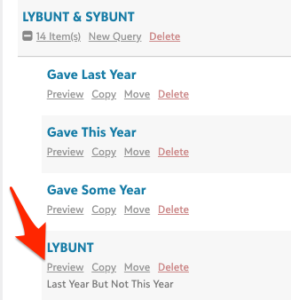How to Retain Donors with a Standard eTapestry Query
How often do you run the LYBUNT query in your eTapestry database?
If your answer is never, rarely, or sometimes, we hope this short post will convince you to run the LYBUNT query more often.
Sustaining fundraising performance is largely based on your ability to renew existing donors year over year. If you can normalize annual revenue from a pool of committed, recurring annual donors, you can grow revenue with new donors and upgrades from renewed donors.
But you can’t retain donors if you don’t know who they are. Fortunately, your Blackbaud® eTapestry® database can help you identify your lapsed donors with the LYBUNT query.
What is LYBUNT?
LYBUNT stands for Last Year But Unfortunately Not This Year.
LYBUNT is a compound query, but you don’t have to worry about building the compound because it is already built for you. LYBUNT comes standard with every eTapestry database.
The LYBUNT query finds all donors that haven’t renewed this year. The LYBUNT query subtracts donors who gave this year from those that gave last year, leaving only those that gave last year but have yet to give this year. The formula for increasing donor renewals in the current year is to remove donors from this LYBUNT list.
The mechanics and logistics of the LYBUNT query are simple. As you add new gifts and payments to eTapestry, constituents in your LYBUNT list will automatically fall out of the query, leaving only those that are left to be renewed.
To generate your LYBUNT list, go to Queries and select Manage Queries. Then, expand the LYBUNT & SYBUNT category and click Preview below the LYBUNT query (or LFYBUNT for a list based on fiscal year).

If you are committed to renewing donors year over year, run a LYBUNT report every month to identify donors that need to be renewed. These former donors from last year are your prospective donors this year.
Using Your LYBUNT List to Retain Donors
Set a goal to renew or contact every donor on your LYBUNT list. As the year progresses and you run the LYBUNT report monthly, work toward a LYBUNT list with no names. If there are donors that aren’t budging from the list, follow up and learn why the donor decided not to give. At a minimum, you can aggregate data on why donors aren’t giving year over year, which can inform fundraising strategies and tactics for the future.
You may be thinking this strategy is too simple or isn’t practical, but even if your fundraising strategy employs a diverse set of fundraising tactics with thousands of annual donors, you should see the same trend in your LYBUNT report: over the course of a year, the number of donors in your LYBUNT report should decrease.
It may seem simple, but LYBUNT is “data analytics.” The LYBUNT query is actionable information that can be applied to real-life scenarios. So leverage the data you have in your eTapestry database for bigger fundraising gains. Start with the standard eTapestry query for LYBUNT.
Looking for customized or more advanced lapsed donor analytics?
We can help. Contact us to learn more about custom analytics for your eTapestry database.
For more on donor retention in eTapestry, check out the webinar Retaining Your Donors: Using eTapestry for Annual Giving and these articles:
Free Download
The Essential Kit to eTapestry Best Practices
- 4x PDF Guides
- 1x Template/Worksheet
- 1x 60-minute Webinar
- Here we can add a benefit, or we can delete one.
Join the 700+ users that already got their kit!
DOWNLOAD NOW